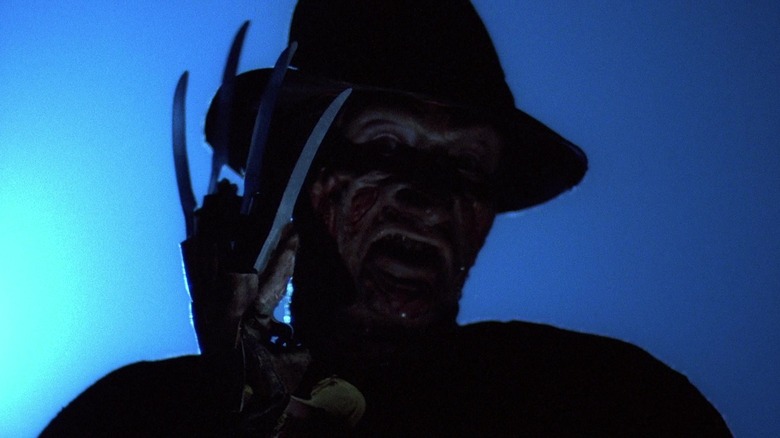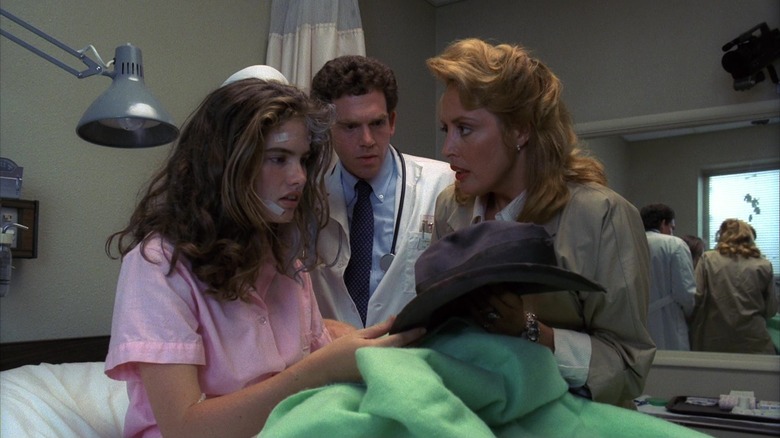Robert Englund Fought With Wes Craven To Save One Of Freddy Krueger's Signature Pieces
In Wes Craven's 1984 horror classic "A Nightmare on Elm Street," Nancy (Heather Langenkamp) and her friends are stalked in their dreams by a mysterious, terrifying ghoul with a burned face and knives affixed to a glove on his right hand. This is Freddy Krueger (Robert Englund), a deceased child murderer from Nancy's hometown of Springwood, Ohio. Freddy isn't just scaring Nancy and her friends, but killing them one-by-one. He's a supernatural entity that can kill people in their dreams. When they die in their dreams, they die in real life.
It's explained that Freddy had been burned to death years earlier by Nancy's parents, as well as all the other adults in town, as revenge for the children he murdered (Freddy was arrested, but not convicted in court thanks to a technicality). Freddy, as revenge, stalked the town's remaining teens in their dreams, taking a great deal of glee in their deaths.
Freddy wore his bladed glove, as it was the preferred torture/murder weapon he liked to use against his victims in the waking world. Freddy's thick, red-and-green sweater, along with his brown fedora, was merely cozy autumnal wear, presumably on his body when he was killed. The ensemble, taken as a whole, makes Freddy truly terrifying. He is monstrous, yet very recognizably human.
It seems that the inclusion of Freddy's hat, however, cause some brief tension during the production of "A Nightmare on Elm Street." According to Englund, in a 2024 oral history by Ringer, he had to make a special request to keep the hat as part of Freddy's costume. He like the way it looked in shadow, and he liked the thought of whipping off the hat to reveal Freddy's charred, bald head underneath.
Robert Englund had to fight to keep Freddy Krueger's hat
Freddy's hat wasn't just an aesthetic choice, but provided a plot point partway through "A Nightmare on Elm Street." Nancy's mother, concerned about Nancy's nightmares, took her daughter to a dream clinic to measure and diagnose any sleep problems. While at the clinic, Nancy falls asleep and encounters Freddy in her dream. She scuffles with the murderous dream demon, and grabs his hat from his head. When she awakens, she has supernaturally pulled Freddy's hat into the waking world. No one understands how that happened.
Englund remembers when Wes Craven and the producer at New Line Cinema, Robert Shea, were first having discussions about Freddy's design, and how there was some push-and-pull over the hat. Shea wanted it gone, and Craven was fine with that decision. Englund, however, wanted it to stay, saying:
"At the last second, they tried to change my hat. I had to fight with Wes and Bob about keeping the fedora, which is Wes' way of seeing Freddy. I had to prove to them how good the fedora looked in silhouette and how I could take it off and reveal my deformed bald head. Even though it's not my idea, I just knew it was right."
He was. Whatever Englund said to Craven and Shea worked, and the hat remained. No one could have predicted at that point that "Nightmare" would become a smash success, nor that it would spawn a massive horror franchise that produced sequels, a TV show, costumes, pinball machines, and video games for the next four decades. The hat became part of Freddy's well-known silhouette. It's hard to imagine a version of the film wherein Freddy was bald the entire time.
Langenkamp even said that she didn't fully acknowledge how scary "Nightmare" was going to be until she saw Englund, in full costume and makeup, on the set. The hat was the filthy, rupled, leathery cherry on top of a bloody, horror sundae.

